 W
WThe Emu Bay Shale is a geological formation in Emu Bay, South Australia, containing a major Konservat-Lagerstätte. It is one of two in the world containing Redlichiidan trilobites. The Emu Bay Shale is dated as Cambrian Series 2, Stage 4, correlated with the upper Botomian Stage of the Lower Cambrian.
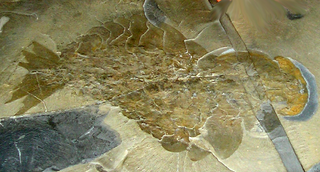 W
WAnomalocaris is an extinct genus of radiodont (anomalocaridid), an order of animals thought to be closely related to ancestral arthropods. The first fossils of Anomalocaris were discovered in the Ogygopsis Shale by Joseph Frederick Whiteaves, with more examples found by Charles Doolittle Walcott in the Burgess Shale. Originally several fossilized parts discovered separately were thought to be three separate creatures, a misapprehension corrected by Harry B. Whittington and Derek Briggs in a 1985 journal article. Anomalocaris is thought to be one of the earliest examples of an apex predator, though others have been found in older Cambrian lagerstätten deposits.
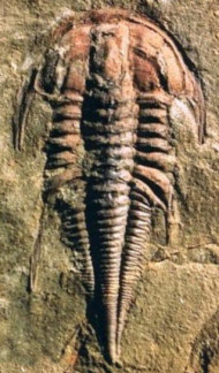 W
WBalcoracania dailyi is a small trilobite of the family Emuellidae. Its fossils have been found in south Australia and Antarctica. It can be recognised by a short field between the front of the axis in the head and the border ridge, and a semi-circular headsheald, as compared to touching glabella and border, and the sub-pentagonal head, in the sister-genus Emuella. Both emuellid genera share eye ridges that are positioned parallel to the frontal and lateral border of the head, prominent genal spines that are a smooth continuation of the lateral margin of the head, a prothorax of 6 segments, with the 5th and 6th merged and carrying large trailing spines. Both genera have in adulthood a highly variable but large number of segments of the opistothorax, although the largest number found in B. dailyi with 97 is much larger than in Emuella (52). B. dailyi is the only known species in this genus.
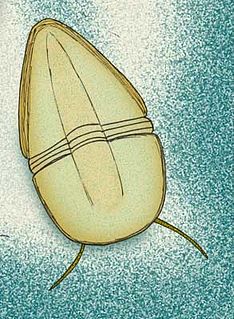 W
WEmucaris fava is an extinct species of soft-shelled trilobite-like arthropod of the nektaspid order from the Lower Cambrian of South Australia. It is the only species classified under the genus Emucaris.
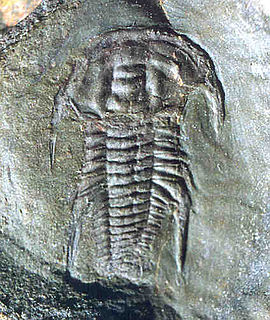 W
WEmuella is a genus of trilobites of the family Emuellidae. Its fossils have been found in South Australia. It can be recognised by touching glabella and frontal border, and the sub-pentagonal head, as compared to, a short field between the front of the axis in the head or glabella and the border ridge, and a semi-circular headsheald in the sister-genus Balcoracania. Both emuellid genera share eye ridges that are positioned parallel to the frontal and lateral border of the head, prominent genal spines that are a smooth continuation of the lateral margin of the head, a prothorax of 6 segments, with the 5th and 6th merged and carrying large trailing spines. Both genera have in adulthood a highly variable but large number of segments of the opistothorax, although the largest number found in B. dailyi with 97 is much larger than in Emuella (52).
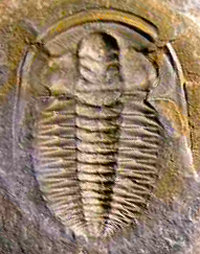 W
WEstaingia bilobata is a species of trilobite from the lower Cambrian period. Their fossils are found chiefly in Australia.
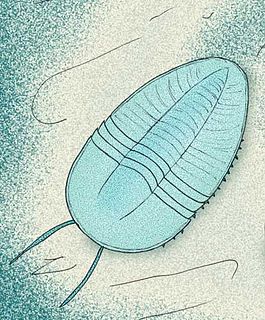 W
WKangacaris is an extinct genus of soft-shelled trilobite-like arthropod of the nektaspid order from the Lower Cambrian (Botomian). K. zhangi is known from South Australia, and K. shui from South-West China.
 W
WMyoscolex is an early animal species known from the Cambrian Emu Bay Shale in South Australia. Originally interpreted as an annelid, it seems to be an arthropod; the possible presence of an Opabinia-like proboscis, eyes, and flaps suggests a plausible relationship with that species. Myoscolex is the earliest known example of phosphotized muscle tissue, and as to which shows distinct annulation.
 W
WNectocaris pteryx is a species of possible cephalopod known from the "early Cambrian" Emu Bay Shale and Chengjiang biota, the "middle Cambrian" Burgess Shale.
 W
WRedlichia takooensis is a species of redlichiid trilobite from the lower Cambrian-aged Emu Shale of Kangaroo Island, Australia.